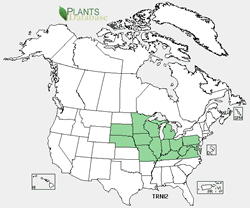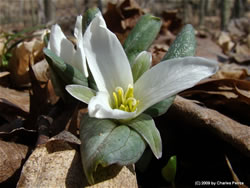Plant of the Week
 Range map of Trillium nivale. States are colored green where the species may be found.
Range map of Trillium nivale. States are colored green where the species may be found.
 Snow trillium is a very diminutive and very showy, white, late winter / early spring wildflower. Image with permission by Charles Peirce.
Snow trillium is a very diminutive and very showy, white, late winter / early spring wildflower. Image with permission by Charles Peirce.
 Blooming very early, snow trilliums are pollinated by beetles similar to the early blooming skunk cabbage. Image with permission by Charles Peirce.
Blooming very early, snow trilliums are pollinated by beetles similar to the early blooming skunk cabbage. Image with permission by Charles Peirce.
 Awakening from its long winter nap, it is a real treat to come across a snow trillium peeking out from the last snows still on the ground. Image with permission by Charles Peirce.
Awakening from its long winter nap, it is a real treat to come across a snow trillium peeking out from the last snows still on the ground. Image with permission by Charles Peirce.
 Snow trillium. Image with permission by Charles Peirce.
Snow trillium. Image with permission by Charles Peirce.
 Snow trillium on the forest floor. Image with permission by Charles Peirce.
Snow trillium on the forest floor. Image with permission by Charles Peirce.
 In one of its commonly encountered habitats finding snow trilliums in bloom along a river is a real treat. Note the open, raw soil that snow trillium is growing. This soil character is always found where snow trilliums grow. Image with permission by Charles Peirce.
In one of its commonly encountered habitats finding snow trilliums in bloom along a river is a real treat. Note the open, raw soil that snow trillium is growing. This soil character is always found where snow trilliums grow. Image with permission by Charles Peirce.
Snow Trillium (Trillium nivale)
By Larry Stritch
The snow trillium is an herbaceous, long-lived, woodland, perennial wildflower with a limited distribution in the Midwestern states of Iowa, Minnesota, Wisconsin, Illinois, Indiana, and Ohio with outlier occurrences in South Dakota, Nebraska, Michigan, Kentucky, Maryland, Pennsylvania, Virginia, and West Virginia.
Snow trillium is truly a harbinger of spring with occasional late winter appearances in March while snow is still on the ground. Snow trillium is never common and can be very rare often with local occurrences in many parts of its range. Within some of these local occurrences very large, dense populations do occur.
“Trillium”, from the Latin tri, refers to the flower parts occurring in threes; and, “llium” from the Latin liliaceous, refers to the funnel-shaped flower. “Nivale”, from the Latin nivalis, pertains to snow, referring to its occasional flowering while there is still snow on the ground.
All trillium species belong to the Liliaceae (lily) family and are rhizomatous herbs with unbranched stems. Trillium plants produce no true leaves or stems above ground. The “stem” is actually just an extension of the horizontal rhizome and produces tiny, scale-like leaves (cataphylls). The above-ground plant is technically a flowering scape, and the leaf-like structures are actually bracts subtending the flower. Despite their morphological origins, the bracts have external and internal structure similar to that of a leaf, function in photosynthesis, and most authors refer to them as leaves.
Trilliums are divided into two major groups, pedicellate and sessile trilliums. In the pedicellate trilliums, the flower sits upon a pedicel that extends from the whorl of bracts, either “erect” above the bracts, or “nodding” recurved under the bracts. In the sessile trilliums there is no pedicel and the flower appears to arise directly from the bracts. Trillium nivale is in the pedicellate group.
Trillium nivale is very dwarfed, with a short, thick rhizome from which a sheath (cataphyll) enclosed scape (stalk of the inflorescence) emerges from the ground to 3 to 5 centimeters tall with a single, terminal flower on an erect, becoming strongly recurved (when in fruit) pedicel, 1 to 2 centimeters long; leaves (actually bracts) three, dark green, definitely petioled, elliptic-ovate or ovate, obtuse to slightly acuminate, 1.5 to 5 centimeters long; petals three, white, very showy, recurved to erect, elliptic-ovate or ovate, obtuse to slightly acuminate, 1.5 to 4 centimeters long, recurved at the middle to form a very funnel-shaped corolla; sepals three, green, spreading, shorter than the petals; fruit a berry, green, indented-globose; brown seeds.
Trillium nivale flowers from mid-March to early April. The species occurs in a range of habitats in limestone-derived soils, calcareous glacial drift or loess deposits. Snow trilliums occur in two different niche habitats that explains there sporadic occurrences. In one habitat, they grow on limestone crevices, limestone talus slopes, bare, sliding soils on the top of limestone cliffs and very steep loess deposits. In these habitats, the soils are sparsely vegetated, if at all with no accumulating organic matter such as leaf mold and litter. In snow trillium’s other niche, it occurs on floodplains at the highest points of flooding were the substrate is gravely or sandy and not packed clay soils and generally calcareous.
For More Information
- PLANTS Profile - Trillium nivale, snow trillium
- Trillium nivale in Flora North America
- Case, F. W. and R. B. Case. 1997. Trilliums. 284 pp. Timber Press. Portland, Oregon.
- Jacobs, D. L. and Jacobs R. L. 1997. Trilliums in Woodland and Garden: American Treasures. 152 pp. Eco-Gardens. Decatur, Georgia.
- Patrick, T. 2007. Trilliums of Georgia. Tipularia 22: 3-22. Georgia Botanical Society.
- Frett, J. 2007. Trilliums at Mt. Cuba Center: A Visitor’s Guide. 75 pp. Mt. Cuba Center, Inc. Greenville, Delaware.

